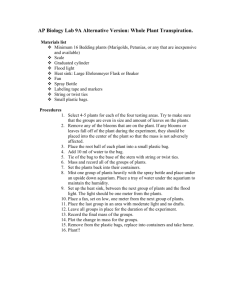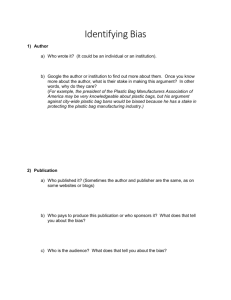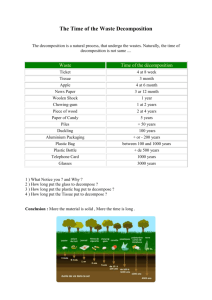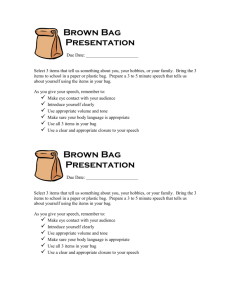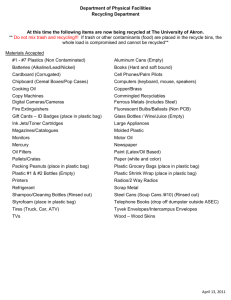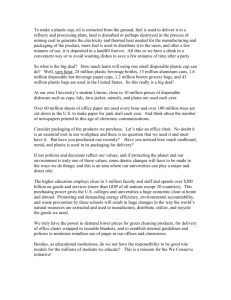TEACHERPREPARATIONANDPROCEDURES
advertisement
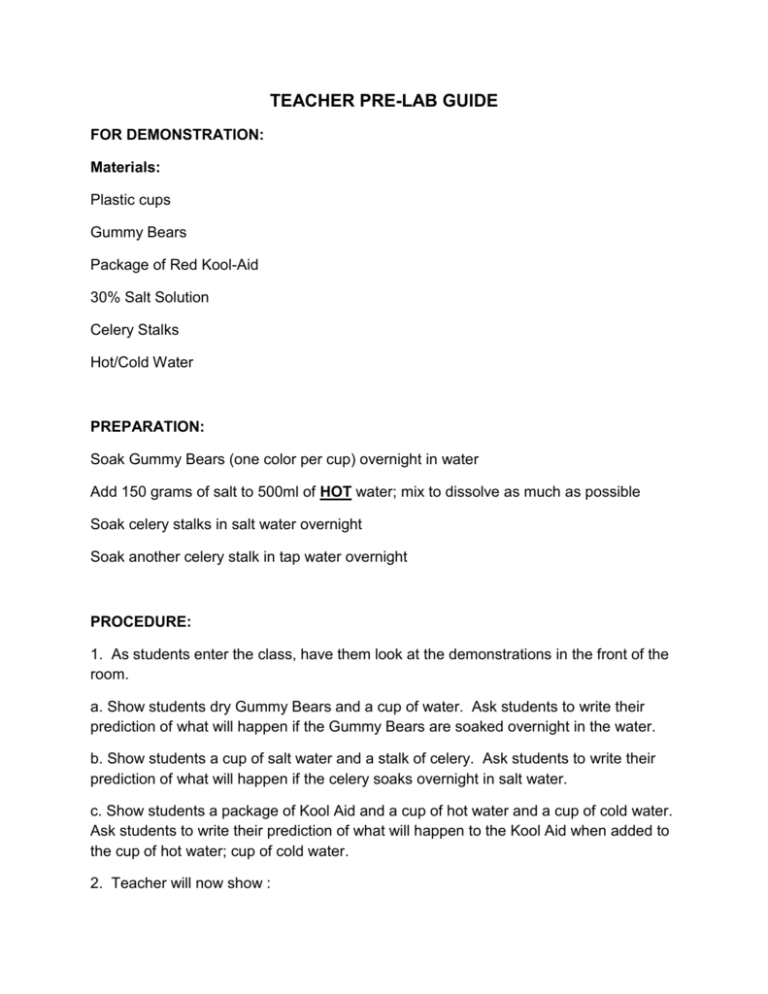
TEACHER PRE-LAB GUIDE FOR DEMONSTRATION: Materials: Plastic cups Gummy Bears Package of Red Kool-Aid 30% Salt Solution Celery Stalks Hot/Cold Water PREPARATION: Soak Gummy Bears (one color per cup) overnight in water Add 150 grams of salt to 500ml of HOT water; mix to dissolve as much as possible Soak celery stalks in salt water overnight Soak another celery stalk in tap water overnight PROCEDURE: 1. As students enter the class, have them look at the demonstrations in the front of the room. a. Show students dry Gummy Bears and a cup of water. Ask students to write their prediction of what will happen if the Gummy Bears are soaked overnight in the water. b. Show students a cup of salt water and a stalk of celery. Ask students to write their prediction of what will happen if the celery soaks overnight in salt water. c. Show students a package of Kool Aid and a cup of hot water and a cup of cold water. Ask students to write their prediction of what will happen to the Kool Aid when added to the cup of hot water; cup of cold water. 2. Teacher will now show : a. Gummy Bears soaked in water b. Celery in salt water; celery in tap water c. the effect of adding one teaspoon of Kool Aid into hot water; one teaspoon of Kool Aid into cold water. 3. Teacher will lead a class discussion of student predictions and explanations of what they learned. For Part A: Diffusion: Materials: Each group needs: Gloves —1 pair for each student 1 Plastic bag with 1 teaspoon of corn starch 1 Plastic cup 1 bottle of Lugol’s Solution (iodine) 1 graduated cylinder Water (150 ml/per group) Preparation: 1. Measure 1 teaspoon of corn starch and add to a plastic bag; close bag and label bag Group1, 2, etc. 2. Put a plastic cup, a graduated cylinder, bottle of Lugol’s solution and the plastic bag with corn starch at each lab group’s station. 3. Provide a large container of tap water at a central location in the classroom 4. Have a place assigned for each group to leave their plastic bag overnight Procedure: 1. Pass out Part A Introduction and Instructions 2. Ask students to read all of the introduction and lab instructions prior to beginning the lab 3. Pass out Handout 1, Part A 4. On second day, pass out Handout 2, Part A For Part B: Osmosis Materials: ALL groups need: 1 plastic cup one 8 inch pre-cut and soaked dialysis tubing 1 graduated cylinder four 8 inch pre-cut pieces of dental floss Scales Gloves – 1 pair per student Water Additional Materials Needed: Groups 1 and 2 need: 20% sucrose solution Bottle of red food coloring Groups 3 and 4 need: Bottle of Phenolphthalein Household Ammonia Groups 5 and 6 need: Bottle of vinegar Bottle of Universal Indicator Solution Groups 7 and 8 need: Distilled water 40 % sucrose solution Bottle of red food coloring Preparation: 1. Cut dialysis tubing into 8 inch sections. Each group will need 1 piece. 2. One or two days before the lab, soak the dialysis tubing in distilled water, tubing should be covered with water. 3. Cut four 8 inch pieces of dental floss for each group: for 8 groups, 32 pieces are needed. 4. To prepare 20% sucrose solution: Place 20 grams of sugar in 100ml of distilled water. To prepare 40% sucrose solution place 40 grams of sugar place in 100ml of distilled water (if this does not dissolve readily, heat the water to hasten the process). 5. Prior to beginning lab, place the following at each lab station: 1 piece of dialysis tubing in distilled water; 1 plastic cup; 1 graduated cylinder; Four 8 inch pieces of dental floss; 1 pair of gloves for each student 6. At a central location, place scales and tap water. 7. At another central location, have the additional materials needed for each group. 8. Have each group label their plastic cup with their group number. 9. Have a designated place for each group to leave their dialysis tubing in plastic cup overnight. Procedure: 1. Pass out Part B Introduction and Instruction 2. Make sure each group member reads all the background information and instructions before starting. 3. Pass out Handout 1, Part B 4. When Handout 1, Part B is completed and turned in, pass out Handout 2, Part B. EXPECTED RESULTS: Part A: the solution inside the bag will eventually become blue – black; the solution outside the bag will become colorless. Part B: for Groups 1 &2 the mass of the dialysis tubing will increase and the solution inside will become pinkish – red; for Groups 3 & 4 the mass of the dialysis tubing will increase and the solution inside will become pinkish - purple; for Groups 5 & 6 the mass of the dialysis tubing will increase and the solution will become pinkish – orange; for Groups 7 & 8 the mass of the dialysis tubing will decrease and the solution in the cup will become light pink. ANSWERS HANDOUT 1 PART A: DATA ANALYSIS QUESTIONS 1. Based on your observations, which substance moved, the Lugol’s solution (iodine) or the starch? Lugol’s Solution or Iodine 2. How did you determine this? Lugol’s Solution/Iodine is an indicator which turns starch blue/black over a period of time. The solution in the plastic bag, which contains the starch, changed to this color and the solution in the plastic cup became lighter. 3. The plastic bag was permeable (lets particles through) to which substance? It was permeable to the Lugol’s Solution/Iodine 4. Is the plastic bag selectively permeable (lets some particles through but not all)? Yes, it did not allow the corn starch to move. 5. Sketch the plastic cup and bag in the space below. Use arrows to indicate the direction of diffusion in this lab. Answers will vary. ANSWERS TO HANDOUT 2, PART A DIFFUSION LAB CONCLUSION/PREDICTION QUESTIONS 1. In your own words define diffusion and give an example. Answers will vary. 2. What happened to the color in the bag that was left overnight? What happened to the color in the plastic cup that was left overnight? It became darker until it spread throughout the bag. The color in the plastic cup became lighter. 3. If the water containing Lugol’s solution (iodine) was heated, predict how this would affect the time of a color change? The rate of the color change in the bag and the plastic cup would increase. 4. Why is Lugol’s solution (iodine) called an indicator? The Lugol’s solution (iodine) changes color from brown to black in the presence of the starch. 5. Molecules tend to move from an area of greater (higher) concentration to areas of lesser (lower) concentration. 6. Is the bag or the plastic cup more concentrated in starch? Bag 7. Is the bag or plastic cup more concentrated in iodine? Plastic Cup DIFFUSION LAB ELABORATE QUESTIONS 1. Predict which way the starch would move, into the bag or out of the bag, if the bag was permeable to starch. It would move out of the bag Explain your answer. Answers will vary. 2. Predict the way Lugol’s solution (iodine) would move, into or out of the bag, since the bag is permeable to Lugol’s solution (iodine). It would move into the bag. 3. Since the bag is permeable to Lugol’s solution (iodine), what color would you expect the solution in the bag to turn? Blue/black. Explain your answer. Answers will vary. What about the solution in the plastic cup? The solution in the plastic cup will get lighter. Explain your answer. Answers will vary. 4. If the bag was permeable to starch, what color would you expect the solution in the bag to turn? It would become a lighter blue. Explain your answer. Answers will vary. What about the solution in the plastic cup? It would begin to turn blue. Explain your answer. Answers will vary. 5. Predict what you think would happen if you did an experiment in which the Lugol’s solution (iodine) was placed in the bag and the starch was in the plastic cup? Answers will vary. BE DETAILED IN WRITING YOUR PREDICTION ANSWERS TO HANDOUT 1, PART B 1. Sketch the tubes in the plastic cups and use arrows to show the movement of the particles for each group. Answers will vary. Sketch the tubes in the plastic cups and use arrows to show the movement of the water molecules for each group. Answers will vary. 2. Which of these solutions are hypertonic for each group? Groups 7 & 8. Which of these solutions are hypotonic for each group? Groups 1, 2, 3, 4, 5 & 6. 3. How do you know which way the particles move? The indicator changed colors in Groups 3, 4, 5, 6. How do you know which way the water molecules moved? Change in mass; in Groups 1, 2, 7, 8 by the movement of the red food coloring. 4. How is this similar to particle movement in cells? Answers will vary. How is this similar to water movement in cells? Answers will vary. Prepared by: Dr. Debbie Payne, Ruth H. Liddell, Shirley K. Scarbrough Alabama State University, Math, Science Partnership, Fall 2012

